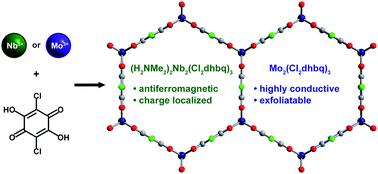当前位置:
X-MOL 学术
›
Chem. Sci.
›
论文详情
Our official English website, www.x-mol.net, welcomes your
feedback! (Note: you will need to create a separate account there.)
Two-dimensional, conductive niobium and molybdenum metal-organic frameworks.
Chemical Science ( IF 7.6 ) Pub Date : 2020-06-02 , DOI: 10.1039/d0sc02515a Michael E Ziebel 1, 2 , Justin C Ondry 1 , Jeffrey R Long 1, 2, 3
Chemical Science ( IF 7.6 ) Pub Date : 2020-06-02 , DOI: 10.1039/d0sc02515a Michael E Ziebel 1, 2 , Justin C Ondry 1 , Jeffrey R Long 1, 2, 3
Affiliation

|
The incorporation of second-row transition metals into metal–organic frameworks could greatly improve the performance of these materials across a wide variety of applications due to the enhanced covalency, redox activity, and spin–orbit coupling of late-row metals relative to their first-row analogues. Thus far, however, the synthesis of such materials has been limited to a small number of metals and structural motifs. Here, we report the syntheses of the two-dimensional metal–organic framework materials (H2NMe2)2Nb2(Cl2dhbq)3 and Mo2(Cl2dhbq)3 (H2Cl2dhbq = 3,6-dichloro-2,5-dihydroxybenzoquinone), which feature mononuclear niobium or molybdenum metal nodes and are formed through reactions driven by metal-to-ligand electron transfer. Characterization of these materials via X-ray absorption spectroscopy suggests a local trigonal prismatic coordination geometry for both niobium and molybdenum, consistent with their increased covalency relative to related first-row transition metal compounds. A combination of vibrational spectroscopy, magnetic susceptibility, and electronic conductivity measurements reveal that these two frameworks possess distinct electronic structures. In particular, while the niobium compound displays evidence for redox-trapping and strong magnetic interactions, the molybdenum phase is valence-delocalized with evidence of large polaron formation. Weak interlayer interactions in the neutral molybdenum phase enable solvent-assisted exfoliation to yield few-layer hexagonal nanosheets. Together, these results represent the first syntheses of metal–organic frameworks containing mononuclear niobium and molybdenum nodes, establishing a route to frameworks incorporating a more diverse range of second- and third-row transition metals with increased covalency and the potential for improved charge transport and stronger magnetic coupling.
中文翻译:

二维导电铌和钼金属有机框架。
将第二排过渡金属纳入金属有机框架中可以极大地提高这些材料在各种应用中的性能,因为后排金属相对于第一排金属具有增强的共价性、氧化还原活性和自旋轨道耦合-行类似物。然而,迄今为止,此类材料的合成仅限于少量金属和结构主题。在这里,我们报道了二维金属有机骨架材料(H 2 NMe 2 ) 2 Nb 2 (Cl 2 dhbq) 3和Mo 2 (Cl 2 dhbq) 3 (H 2 Cl 2 dhbq = 3,6)的合成-二氯-2,5-二羟基苯醌),其特征是单核铌或钼金属节点,并通过金属到配体电子转移驱动的反应形成。通过X 射线吸收光谱对这些材料进行表征表明,铌和钼均具有局部三棱柱配位几何形状,这与它们相对于相关第一行过渡金属化合物增加的共价一致。振动光谱、磁化率和电子电导率测量的结合表明,这两种框架具有不同的电子结构。 特别是,虽然铌化合物显示出氧化还原捕获和强磁相互作用的证据,但钼相是价离域的,有大极化子形成的证据。中性钼相中的弱层间相互作用使得溶剂辅助剥离能够产生少层六角形纳米片。总之,这些结果代表了含有单核铌和钼节点的金属有机框架的首次合成,建立了一条包含更多样化的第二和第三行过渡金属的框架的路线,这些金属具有增加的共价性和改善电荷传输和潜力的潜力。更强的磁耦合。
更新日期:2020-07-08
中文翻译:

二维导电铌和钼金属有机框架。
将第二排过渡金属纳入金属有机框架中可以极大地提高这些材料在各种应用中的性能,因为后排金属相对于第一排金属具有增强的共价性、氧化还原活性和自旋轨道耦合-行类似物。然而,迄今为止,此类材料的合成仅限于少量金属和结构主题。在这里,我们报道了二维金属有机骨架材料(H 2 NMe 2 ) 2 Nb 2 (Cl 2 dhbq) 3和Mo 2 (Cl 2 dhbq) 3 (H 2 Cl 2 dhbq = 3,6)的合成-二氯-2,5-二羟基苯醌),其特征是单核铌或钼金属节点,并通过金属到配体电子转移驱动的反应形成。通过X 射线吸收光谱对这些材料进行表征表明,铌和钼均具有局部三棱柱配位几何形状,这与它们相对于相关第一行过渡金属化合物增加的共价一致。振动光谱、磁化率和电子电导率测量的结合表明,这两种框架具有不同的电子结构。 特别是,虽然铌化合物显示出氧化还原捕获和强磁相互作用的证据,但钼相是价离域的,有大极化子形成的证据。中性钼相中的弱层间相互作用使得溶剂辅助剥离能够产生少层六角形纳米片。总之,这些结果代表了含有单核铌和钼节点的金属有机框架的首次合成,建立了一条包含更多样化的第二和第三行过渡金属的框架的路线,这些金属具有增加的共价性和改善电荷传输和潜力的潜力。更强的磁耦合。











































 京公网安备 11010802027423号
京公网安备 11010802027423号